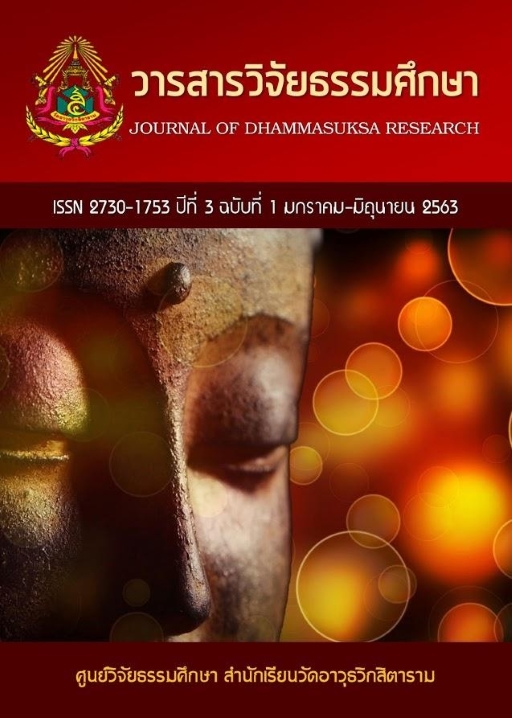The learning development on achievement in history of the ayutthaya kingdom by using cycle model learning (4 mat) for matthayom 2 students
Keywords:
Learning management, Cycle Model learning (4 MAT), Learning AchievementAbstract
The objectives of this research were: (1) to compare the history learning achievement of matthayom 2 students who were taught by using cycle model learning (4 MAT) and a regular classroom learning method (2) to investigate the students' satisfaction towards learning by using cycle model learning (4 MAT). This research was experimental research, by using a simple random sampling method, the study sample was 30 matthayom 2 students in the second semester of the academic year 2019 at Watjuntrawat (Sukprasarat) school, Phetchaburi. The sample was divided into two groups: Group 2/7 - the experimental group comprising 30 students being taught by using cycle model learning (4 MAT) and the other group was the 30 students being taught by using the regular classroom learning method. The research instruments consisted of (1) learning management plans containing teaching and learning activities based on cycle model learning (4 MAT) (2) a learning achievement test and (3) a questionnaire to evaluate the students' satisfaction towards learning management using cycle model learning (4 MAT). The statistics used for analyzing the data were percentage, mean, standard deviation, and t-test.
The research findings were as follows: (1) The learning achievement in the historical subject of the students who use the cycle model learning activities (4 MAT) were higher than the students who use normal activities at the statistical level of .01 (2) The students who learned by using cycle model learning (4 MAT) in the historical subject for matthayom 2 students in overall were satisfied at the highest level.
References
กันติกาน สืบกินร. (2551). การศึกษาผลการเรียนรู้และความสามารถในการแก้ปัญหาทางวิทยาศาสตร์ของนักเรียนชั้นประถมศึกษาปีที่ 6 โดยจัดการเรียนรู้แบบ 4 MAT. วิทยานิพนธ์การศึกษามหาบัณฑิต สาขาวิชาหลักสูตรและการสอน มหาวิทยาลัยศิลปากร, นครปฐม.
ชัยวัฒน์ สุทธิรัตน์. (2553). 80 นวัตกรรมการจัดการเรียนรู้ที่เน้นนักเรียนเป็นสำคัญ: สอนประวัติศาสตร์ให้เด็กมีความสุข. กรุงเทพฯ: แดเน็กซ์ อินเตอร์คอร์ปอเรชั่น.
ธัญญาพร ก่องขันธ์. (2554). ผลการพัฒนากิจกรรมการเรียนรู้ เรื่อง การอนุรักษ์ทรัพยากรธรรมชาติกลุ่มสาระสังคมศึกษา ศาสนา และวัฒนธรรม โดยใช้การจัดกิจกรรมการเรียนรู้แบบ4MAT ที่มีต่อผลสัมฤทธิ์ทางการเรียน และความคิดสร้างสรรค์ ของนักเรียน โรงเรียนบ้านโคกม่วง (ดำประชาอุทิศ) อำเภอเขาชัยสน จังหวัดพัทลุง. วิทยานิพนธ์ปริญญามหาบัณฑิต, มหาวิทยาลัยขอนแก่น.
ธัญมา หลายพัฒน์. (2550). วิธีการสอนแบบ 4 MAT ที่มีต่อผลสัมฤทธิ์ทางการเรียนเรื่องเพศศึกษาของนักเรียนชั้นประถมศึกษาปีที่ 5. วิทยานิพนธ์ศึกษาศาสตรมหาบัณฑิต สาขาวิชาสุขศึกษามหาวิทยาลัยศรีนครินทรวิโรฒ, กรุงเทพฯ.
ประพันธ์ศิริ สุเสารัจ. (2558). 4 MAT: ลีลาการสอนของครูและพฤติกรรมการเรียนรู้ของผู้เรียน. Thailand Education. สำนักพิมพ์แห่งจุฬาลงกรณ์มหาวิทยาลัย.
พระมหาก้องนภา สิงห์ศร.(2560). ผลการจัดการเรียนรู้แบบ 4 MAT ที่มีต่อผลสัมฤทธิ์ทางการเรียนกลุ่มสาระการเรียนรู้สังคมศึกษา ศาสนา และวัฒนธรรมและแรงจูงใจใฝ่สัมฤทธิ์ของนักเรียนชั้นประถมศึกษาปีที่ 5.วิทยานิพนธ์ปริญญามหาบัณฑิต, มหาวิทยาลัยสงขลานครินทร์.
พวงรัตน์ ทวีรัตน์. (2539). การสร้างและพัฒนาแบบทดสอบผลสัมฤทธิ์. กรุงเทพฯ: สำนักทดสอบทางการศึกษาและจิตวิทยา มหาวิทยาลัยศรีนครินทรวิโรฒ.
เพชรรัตน์ คำสมจิตร. (2557). การพัฒนาการคิดอย่างมีวิจารณญาณและผลสัมฤทธิ์ทางการเรียนของนักเรียนชั้นมัธยมศึกษาปีที่ 3 โรงเรียนภูกระดึงวิทยาคม โดยใช้รูปแบบการสอน 4 MAT รายวิชา ส23101 สังคมศึกษา ศาสนา และวัฒนธรรม. วิทยานิพนธ์ปริญญามหาบัณฑิต, มหาวิทยาลัยขอนแก่น.
ลีลาวดี วัชโรบล. (2553). การพัฒนารูปแบบการเรียนการสอนทางไกลโดยบูรณาการกิจกรรมการเรียนรู้แบบ 4 MAT และทฤษฎีปลูกฝังนิสัยเพื่อพัฒนาเหตุผลเชิงจริยธรรมของนักเรียนชั้นมัธยมศึกษาปีที่ 3 ในเขตกรุงเทพมหานคร. วิทยานิพนธ์ปริญญามหาบัณฑิต มหาวิทยาลัยธุรกิจบัณฑิตย์, กรุงเทพฯ.
สิริวรรณ ตะรุสานนท์. (2542). การศึกษาผลสัมฤทธิ์ทางการเรียนและความสามารถในการคิดแก้ปัญหาของนักเรียนชั้นมัธยมศึกษาปีที่ 1 ที่เรียนวิชาสังคมศึกษา โดยการจัดกิจกรรมการเรียนการสอนแบบ 4 MAT กับการจัดกิจกรรมการสอนแบบวิธีการทางวิทยาศาสตร์.ปริญญานิพนธ์ กศ.ม. (การมัธยมศึกษา). กรุงเทพฯ: มหาวิทยาลัยศรีนครินทรวิโรฒ.
อริศรา ภูคากอง (2553). ผลการจัดการเรียนรู้โดยใช้รูปแบบ 4 MAT ที่มีต่อผลสัมฤทธิ์ทางการเรียนความคงทนในการเรียนรู้ เรื่อง จำนวนเต็ม ชั้นมัธยมศึกษาปีที่ 1. วิทยานิพนธ์ครุศาสตรมหาบัณฑิต สาขาวิชาคณิตศาสตร์ศึกษา มหาวิทยาลัยราชภัฏมหาสารคาม, มหาสารคาม.
Appell, Cladla Jane. (1991). The Effect of the 4 MAT System of instruction on Academic Achievement and Attitude in the Elementary Music Classroom (Four Mat).
Dissertation Abstracts international. 52(11): 3851?A.
Bloom, Benjamin S. (1976). Human Characteristics and School Learning. NewYork: Kingsport Press.
Bowers, Patricia Shane. (1987). The Effect of the 4 MAT System on Achievement and Attitudes in Science. Dissertation Abstracts International. 49(90): 2605-A.
Good, Carter V. (1959). Dictionary of Education. New York: Mc Graw?Hill.
Bowers, Patricia Shane. (1973). Dictionary of Education. 3rd Ed. New York: McGraw ? Hill Book Inc.
McCarthy, Mice. (1990). Using the 4 MAT System to Bring Learning Styles to Schools. Eric Accession: NISC Discover Report.
Powell, Marvin. (1963). The Psychology of Adolescence. New York: The BoblessMerrill.

Downloads
Published
How to Cite
Issue
Section
Categories
License
Copyright (c) 2020 Journal of Dhammasuksa Research

This work is licensed under a Creative Commons Attribution-NonCommercial-NoDerivatives 4.0 International License.

